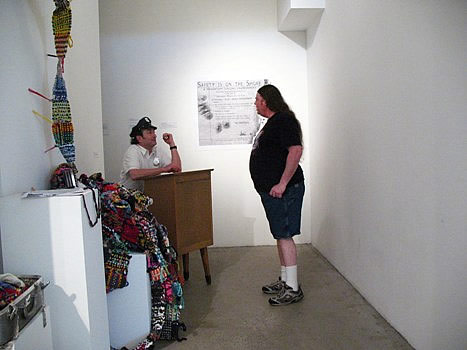Barnsdall Arts Center ,
Jan 24, 2010 - Apr 18, 2010
Los Angeles, CA, USA
Luck of the crowd: Review of Actions, Conversations and Intersections
by Rodrigo Marti
A major tension around participatory work brought up between Kester and Bishop lies in the parameters of aesthetics itself. Kester seems to argue for a widening of the strictly guarded aesthetic conventions while pointing out Bishop’s perpetuation of a narrow understanding of power dynamics between the ‘players’ (from the artist, the viewer and curator, to institutional and global concerns) in the art ‘experience’, as well as how those players are able to enter, engage or relate to work and the art field itself. By encouraging the haptic or tactil nature of aesthetic experience Kester is effectively throwing a wrench into our current retinal and rational or cerebrally determined evaluation of art. Elevating the individual and contextual characteristics of aesthetic understanding from the art market’s top-down logic, widening the frame while moving our understanding of art towards zones that affect art but have little relation to its professional status. Many such example are found in what are called community-based art practices. In this sense AC&I functioned as a platform for the growing concerns and differing strategies of artists working with a more engaged and inclusive approach to art making, to curatorial practices in general, and to institutional negotiations. While I find no issue with works concerning themselves with realizing or staging attempts towards the ideals of ‘democracy and emancipation’ even at their most utopic, the AC&I exhibit speaks to the current need to rework the critical dialogue and language surrounding the problems of working within the overtly collaborative, interpersonal and political dynamics of art and culture.
The numerous artworks and activities present at AC&I were too many for one person to take in. The exhibition was able to take a participatory focus and use it to call attention to an institutional boundary while setting the stage for experimentation with group and community activities. This small and enthusiastic survey functioning under a strong ‘localist’ premise and a decidedly grassroots logic, echoed the Municipal Gallery's mission to dedicate its programming to the city of Los Angeles and particularly to its minority populations.
Democracy and emancipation has long concerned artists, thinkers and activists alike. It is both the excitement and skepticism brought on by the present popularity of "democracy" as a fix all term that can so often seem overly problematic or naí¯ve. AC&I serves as an example of the range of interests of those who are looking for new forms to combat the confinement of the art world, to further open up their practices and more effectively speak toward the growing issues that increasingly stretch from our backyards to the global stage.
By having actions present not as a differentiated educational platform but as works operating in their own right, often with a strong pedagogical bent, the exhibition's community focus was realized by prioritizing and realizing diverse forms of engagement. AC&I's ideological position, with sensibilities toward interaction, flexibility, plurality, immediacy, and civil agency in art and culture creates an unabated set of potentials implicating the effectiveness of collectivity in today’s increasingly unstable economic reality. The difficulty in assessing or judging the art was not necessarily all that difficult in the end. Those artworks that peeked my interests (sometimes literally "speaking" to me) dragged me in and let me tinker as I wish. Like any compelling art practice, conveying vulnerability in its successes and failures, these projects maintain our interest and allow us to think critically about the content of the work and the way we are implicated in culture.
* * *
SOURCES:
Bishop, Claire. “Antagonism and Relational Aesthetics” October, p.51-79. Fall 2010.
Bishop, Claire. ed. “Participation” London and Cambridge. Whitechapel/MIT Press. 2006.
Kester, Grant. “Grant Kester Responds to Claire Bishop” ArtForum, May 2006.
Scott, Andrea K. “High-Wire Act “New York Times. February, 2010.
The Finishing School. “Wetlab project” Website. 2009, http://www.finishing-school.net/wetlab.html.
Actions, Conversations and Intersections website
|











